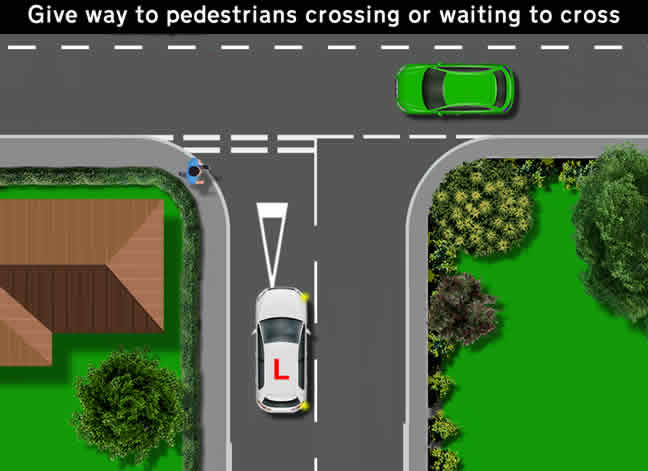When dealing with T-junctions, you’ll come across unmarked, marked junctions and controlled junctions. Unlike stop T-junctions which always have a stop sign and road markings (marked), a give way T-junction may have:
- Road markings but no sign
- Road markings and a sign
- No road marking and no sign
What Does Give Way at a T-junction Mean?
When approaching a T-junction, you are on the minor road, intending to merge into the major road. ‘Give way’ means that you must slow down and prepare to stop in order to ‘give way’ to traffic on the major road.
Give Way Road Signs and Road Markings
In terms of road markings, a give way T-junction has two dashed lines across your side of the road. Also painted on the road is an inverted triangle, providing an additional warning to the junction ahead. A give way road sign is represented as an inverted triangle with a red border with the ‘give way’ text contained inside.

Advance Give Way Warning Signs
On certain give way junctions that are more hazardous to drivers, you may see advance warning signs. A typical advance warning sign is the inverted give way triangle along with an information plate detailing the distance to the junction. Distances are often 50, 100 or 150 yards. Other advance warnings may be put in place for merging onto a dual carriageway for example.

What are the Rules at Give Way Junctions?
As you approach a give way T-junction, you must slow down and if necessary stop just prior to crossing the dashed lines. If you’re not sure where to stop and need help with a reference point, see where to stop at T-junctions. Whilst waiting on the minor road, wait for a safe gap in the traffic before merging onto the major road. Vehicles on the major road have priority. Stop just prior to crossing the junction lines.

Junctions is a common place for pedestrians to cross the road. As you approach the T-junction, you should also give way to pedestrians crossing, or waiting to cross. Avoid gesturing pedestrians to cross as this may make them make impulsive decisions without properly checking.

Unmarked Give Way T-Junctions
Although unmarked T-junctions do not have give way signs or give way road markings, you’ll still need to give way to traffic that’s already on the major road you intend on merging onto.
It can be a little more challenging to know where to stop at unmarked T-junctions due to there being no lines to stop at. Essentially, you’ll need to think where the minor road stops and where the major road begins. Draw an imaginary line between the furthest kerbstones (as can be seen with the yellow dashed line) and use this as your give way road markings.

Do You Have to Stop at a Give Way Junction?
Whether or not you need to stop at a give way junction depends on what you can or cannot see. If it’s an open junction and you can clearly see that it’s safe to merge onto the major road without stopping, then it’s perfectly acceptable to continue without stopping. If it’s a blind or closed junction and you cannot determine whether there’s approaching traffic on the major road, you’ll almost certainly need to stop.